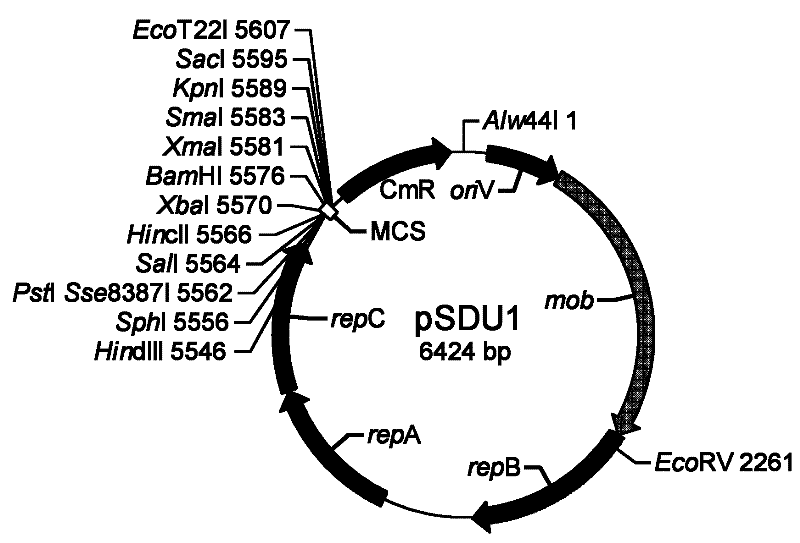Small shuttle plasmid pSDU1 with chloramphenicol resistant gene for Acidithiobacillus caldus
A thermophilic Thiobacillus and resistance gene technology, applied in the fields of molecular biology and bioengineering, can solve the problems of cumbersome operation, low plasmid carrying capacity, restricted plasmid use, etc., and achieve high transformation efficiency, large carrying capacity, and high stability. sexual effect
- Summary
- Abstract
- Description
- Claims
- Application Information
AI Technical Summary
Problems solved by technology
Method used
Image
Examples
Embodiment 1
[0036] 1. Extraction of plasmid pACYC184 (purchased from Biovector Co., LTD):
[0037] Use the TaKaRa MiniBEST Plasmid Purification Kit Ver.2.0 plasmid mini-extraction kit (purchased from TaKaRa Company, item number: DV801A), and the specific operation is as follows:
[0038] (1) Add corresponding antibiotics to 20ml LB medium, inoculate with 1% activated bacteria, culture at 37°C, 200rpm, with shaking for 12-14h.
[0039] (2) Pour 5ml of cultured bacterial solution into a centrifuge tube, centrifuge at 12,000rpm for 3min, and aspirate the supernatant.
[0040] (3) Add 250 μl of Solution I (containing RNaseA1), Vortex to the collected cells, fully suspend the cell pellet and transfer the cell solution to a 1.5 ml EP tube.
[0041] (4) Add 250 μl of Solution II, and gently turn it up and down 5-6 times to fully lyse the bacteria and form a transparent solution.
[0042] Note: The bacterium must be fully lysed to form a transparent solution, and the operation must be rapid, an...
Embodiment 2
[0080] 1. Extraction of plasmid pJRD215 (purchased from Biovector Co., LTD): refer to 1 in Example 1.
[0081] 2. Amplify oriV, mob, rep and other genes from plasmid pJRD215:
[0082] Plasmid Use primers Pr4 and Pr5 to amplify oriV, mob, rep and other genes from plasmid pJRD215. Primer Pr4 contains an Alw 44 I restriction site, and Pr5 contains an EcoT 22I restriction site
[0083] (1) The sequences of the above primers are as follows:
[0084] Pr4: CTTCGTGCACTCCTTGCAATACTGTGTT
[0085] Pr5: CTTCATGCATCCCAAGCTTAGAGCATACATCTGGAAGCA
[0086] (2) Preparation of reaction system:
[0087] wxya 2 O: 21 μl; Premix PrimerSTAR HS: 25 μl; Primer Pr4: 1.5 μl (0.3 μM final conc.); Primer Pr5: 1.5 μl (0.3 μM final conc.); Template DNA (plasmid pJRD215): 1 μl.
[0088] (3) Polymerase chain reaction (PCR) cycle:
[0089] The specific steps are: 94°C for 2min; then 98°C for 10s, 55°C for 15s, 72°C for 6min, a total of 29 cycles; finally 72°C for 10min.
[0090] (4) As detected by DNA g...
Embodiment 3
[0092] 1. Construct the intermediate plasmid pSDU:
[0093] The chloramphenicol resistance gene containing the P2 promoter obtained in Example 1 and the ori V, mob, rep and other genes of the plasmid pJRD215 obtained by PCR amplification in Example 2 were doubled using Alw 44 I and EcoT 22 I respectively. Digestion, purification and ligation with T4 DNA ligase (10×T4DNALigase Buffer 1μl, T4DNALigase 1μl, plasmid fragment 1.5μl, gene bphC fragment 6.5μl, 16°C, overnight ligation).
[0094] Add the ligation reaction solution to 50 μl E.coli DH5α competent cells, mix lightly, put in ice bath for 30 min, 42°C for 90 s, immediately put in ice bath for 5 min, add 0.5ml LB liquid medium, incubate at 37°C for 1 h, and spread the above transformation solution Spread on LB medium solid plates containing chloramphenicol, and culture overnight at 37°C.
[0095] Pick the transformant colony on the chloramphenicol screening plate, inoculate it into LB liquid medium containing chloramphenic...
PUM
 Login to View More
Login to View More Abstract
Description
Claims
Application Information
 Login to View More
Login to View More - R&D
- Intellectual Property
- Life Sciences
- Materials
- Tech Scout
- Unparalleled Data Quality
- Higher Quality Content
- 60% Fewer Hallucinations
Browse by: Latest US Patents, China's latest patents, Technical Efficacy Thesaurus, Application Domain, Technology Topic, Popular Technical Reports.
© 2025 PatSnap. All rights reserved.Legal|Privacy policy|Modern Slavery Act Transparency Statement|Sitemap|About US| Contact US: help@patsnap.com



